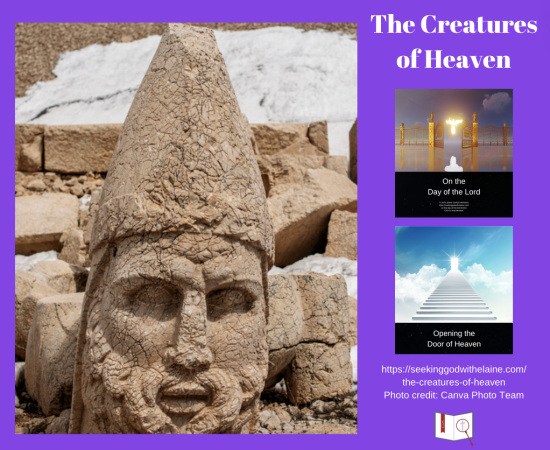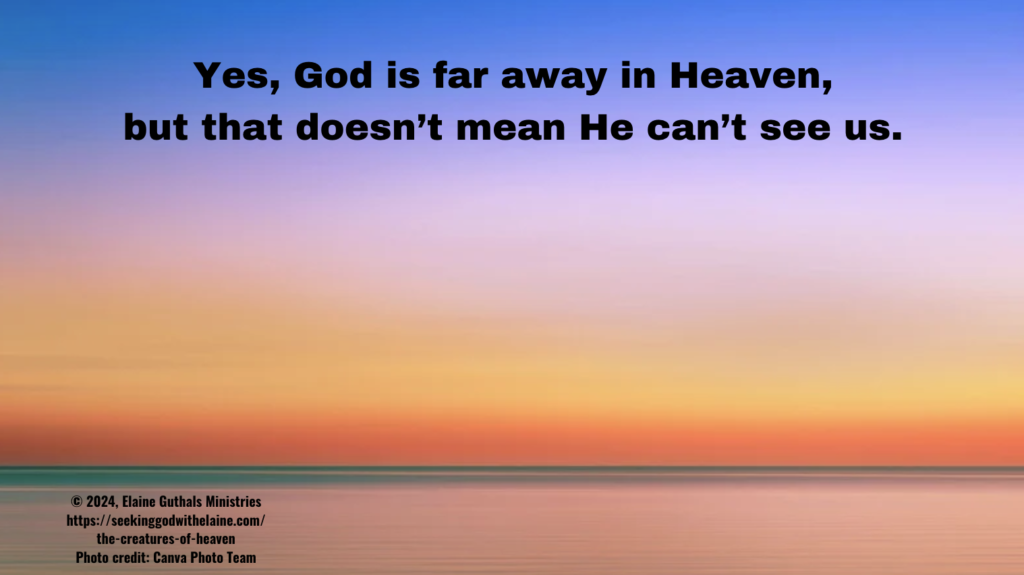The living creatures around God’s throne have an interesting but somewhat scary description. This devotional reading looks at what these creatures are and how they worship with the elders.
Nuggets
- The glass sea is a barrier between Heaven and earth.
- The description of the four living creatures creates an interesting visual.
- Like the elders, the living creatures continuously praise God.
- The elders and the living creatures feed off each other to give God perpetual praise.

One of the hardest parts of Revelation for me to understand is the living creatures that guard the throne. It is probably because they are so foreign to anything I know.
John’s description seems limited, but let’s see what we can find in God’s Word to help us understand.
Let's Put It into Context
To read devotions in the On the Day of the Lord theme, click the button below.
Devotions in the Opening the Door of Heaven series
The Glass Sea
“and before the throne there was as it were a sea of glass, like crystal …” (Rev. 4: 6 ESV)
The glass sea is a barrier between Heaven and earth.
When we think of a glass sea, what picture do we see in our mind? We see calm water. It is never broken up by waves or even ripples. We may also bend over and look at ourselves reflected in the still water.
Here, the glass sea may have a more spiritual meaning. It brings to mind the bowl in Solomon’s temple where the priests did their ritual washing (I Kgs. 7: 23-26).
The sea being as crystal is important. That makes it see through.
Yes, God is far away in Heaven, but that doesn’t mean He can’t see us. We know God is all-seeing. “The eyes of the Lord are in every place, keeping watch on the evil and the good” (Prov. 15: 3 ESV).

But we can’t fathom how that would be if Heaven has a floor.
A glass floor is the perfect explanation. There is no impediment keeping God from seeing us.
In my opinion — and I may be right or wrong — I would say that the glass sea is on top of the chasm that Jesus talked about in His parable — or it is the chasm itself (Lk. 16: 26).
The glass sea allows God to see us and keeps us from going through if we are not one of His children.
I think that element of judgment is an integral part of the glass sea. Well, it is in front of God’s throne, isn’t it?
The Creatures
“… And around the throne, on each side of the throne, are four living creatures, full of eyes in front and behind: the first living creature like a lion, the second living creature like an ox, the third living creature with the face of a man, and the fourth living creature like an eagle in flight. And the four living creatures, each of them with six wings, are full of eyes all around and within …” (Rev. 4: 6-8 ESV)
The description of the four living creatures creates an interesting visual.
I’ve long wondered what these creatures of Heaven actually are. They have always seemed a little fantastical to me.
When the door of Heaven was opened to John, he saw some amazing sights. John was running blind with only his limited vocabulary to describe amazing creatures.
They may have the “physical” appearance of beasts, but their character is good. John did the best he could — and wrote exactly the descriptions God wanted us to have.
These creatures have been identified by some as the cherubim, a special order of angels, which represents God’s presence. When a distinction is made, most angels are identified as cherubim. “Then I looked, and behold, on the expanse that was over the heads of the cherubim there appeared above them something like a sapphire, in appearance like a throne” (Ezek. 10: 1 ESV).
I am not convinced these living creatures are cherubim, but we’ll talk about that in the Making the Connections section.
Eyes
Exell saw significance of the creatures having eyes before and behind. They could both comprehend history and prophecy.
The eyes within, I think, play a vital role. It is through this self-examination that we make our choices to submit to God. Even angels have the choice, because Satan chose not to submit.
Resource
God is all-seeing, but we aren’t.
Wings
The creatures’ possession of six wings makes us think these are angels. Donne proposed that the wings were given to the creatures so that they could distance themselves from the world while being ready to provide support when their watch shows we are in need.
Resource
Maybe. We aren’t really told any other task given to the creatures other than worshiping God.
Characteristics
But for the most part, each creature has individual characteristics. The lion represents wild beasts. Domesticated animals are represented by the ox. The representative for birds is the eagle. Last, man is represented. Each are at the top of the food chain.
Jewish tradition connects these creatures to the groupings of the twelve tribes of Israel situated around the tabernacle. There were four groups with three tribes each. Each group had one tribe that was stronger than the other two, and each had a symbol.
• Judah, the lion — courage
• Ephraim, the bull or ox — industriousness
• Dan, the eagle — sight with cognizant comprehensibility
• Reuben, man — ability to reason and apply
I think the appearance of the creatures are for the UNR book — understanding not required. We do, however, have to understand their purpose.
The Worship of the Creatures
“… and day and night they never cease to say, ‘Holy, holy, holy, is the Lord God Almighty, who was and is and is to come!’” (Rev. 4: 8 ESV)
Like the elders, the living creatures continuously praise God.
Day and Night
The task assigned to the creatures is to praise God 24/7/365/eternity.
God is worthy of our praise. In fact, the reason for Heaven is to give Him that continual praise.
We tend to think that continual worship is just a Heaven thing. Yes, rest is an earth thing.
Paul told us we aren’t supposed to rest from worship. “Rejoice always, pray without ceasing, give thanks in all circumstances; for this is the will of God in Christ Jesus for you” (I Thess. 5: 16-18 ESV).
We have to maintain an attitude of worship.

Think about it. During creation — however long it took — each day ended with an evening-and-morning-made-the-day statement.
The seventh day didn’t get one. The day of rest — the day of worship — will never end.
Our worship was always meant to be continuous.
Wilson made an interesting comment. He wrote, “Worship, as distinct from prayer and praise and thanksgiving, is the conscious lifting up of the soul to God in contemplation of Him, in His Being and acts, whether towards ourselves in particular, or towards our whole race, or in all His works, according to our knowledge of them.”
Resource
How many times do we think our prayer is our worship? We sure think our songs of praise are! Do we even consider our gratitude worship?
So, what is true worship? Wilson helped us with that.
- We receive when we worship, but we have to follow that out and expand on it.
- God reveals Himself to us.
- God envelops us to sanctify us.
- Worship strengthens our relationships with God.
- As we learn more about God and draw closer to Him, our worship increases and broadens.
Knowledge and worship have to go hand in hand. We must actively take part — in seeking to know God better and in giving Him the glory and honor He deserves.
We have to get worship down to the heart level. We have to be totally focused on being more and more in tune with God.
Never Cease to Say
By repeating holy three times, it is signifying God’s supreme holiness.
John would have known Isaiah’s account of seeing God. “In the year that King Uzziah died I saw the Lord sitting upon a throne, high and lifted up; and the train of his robe filled the temple. Above him stood the seraphim. Each had six wings: with two he covered his face, and with two he covered his feet, and with two he flew. And one called to another and said: ‘Holy, holy, holy is the Lord of hosts; the whole earth is full of his glory!’” (Isa. 6: 1-3 ESV).
This near to the throne — and continually being there — they would know of God’s purity. It would always be on display to them.
Total focus is on God. We have to humbly give Him the glory He has due.
Interaction between the Living Creatures and the Elders
“And whenever the living creatures give glory and honor and thanks to him who is seated on the throne, who lives forever and ever, the twenty-four elders fall down before him who is seated on the throne and worship him who lives forever and ever. They cast their crowns before the throne, saying, ‘Worthy are you, our Lord and God, to receive glory and honor and power, for you created all things, and by your will they existed and were created’” (Rev. 4: 9-11 ESV)
The elders and the living creatures feed off each other to give God perpetual praise.
Glory and Honor
Revelation 4: 9-11, to me, seems contradictory to the previous verses. Some words throw me off.
- “… whenever the living creatures give glory and honor and thanks …” (Rev. 4: 9 ESV).
- “the twenty-four elders fall down before him …” (Rev. 4: 10 ESV).
Isn’t the whenever always? Then when do the elders know it’s time to fall down?
We’ve talked that it is mainly thought that the elders were human. If that is so, they got the humility down pat.
Well, they are at the foot of the throne of the most pure, most holy Being. That would make you realize how worthy God is and how unworthy we are.
Casting Their Crowns
Some like to think they are going to get to keep their crowns. Nope, our crowns are going to be given to the Lamb.
If the crowns symbolize eternal life, does that mean we will lose the eternal life? No. It means we are showing gratitude for it.
We only have the crowns because God designed the Plan of Salvation to restore our relationships with Him. That changed our classification.
“But you are a chosen race, a royal priesthood, a holy nation, a people for his own possession, that you may proclaim the excellencies of him who called you out of darkness into his marvelous light” (I Pet. 2: 9 ESV).
We usually focus on the priest part. We have a tendency to skip right over the royal part. “To him who loves us and has freed us from our sins by his blood and made us a kingdom, priests to his God and Father, to him be glory and dominion forever and ever. Amen” (Rev. 1: 5-6 ESV).
But think of it. We are children of God, the Most High King. Of course, we are royalty!
We will also be royalty because we will be the bride of Christ. We’ll talk about that later, too (Rev. 19: 6-9).
We will also be royalty because we will have been victorious over sin.
What better way to honor the author of our salvation and eternal life? Casting our crowns is a practical display of our love, gratitude, and reverence. We will be showing our commitment to the One Who saved us.
Created All Things
God created something out of nothing. “In the beginning, God created the heavens and the earth. The earth was without form and void, and darkness was over the face of the deep. And the Spirit of God was hovering over the face of the waters” (Gen. 1: 1-2 ESV).
Jesus was not only present at creation, but He also took an active part in it. “In the beginning was the Word, and the Word was with God, and the Word was God. He was in the beginning with God. All things were made through him, and without him was not any thing made that was made. In him was life, and the life was the light of men” (Jn. 1: 1-4 ESV).
Why did God create us when He knew we would disobey Him? Why did He have the Plan of Salvation ready even before He created us? “Blessed be the God and Father of our Lord Jesus Christ, who has blessed us in Christ with every spiritual blessing in the heavenly places, even as he chose us in him before the foundation of the world, that we should be holy and blameless before him …” (Eph. 1: 3-4 ESV).
Making the Connections #1
I have to process whether John’s creatures are the same as Ezekiel’s creatures and Isaiah’s creatures.
John’s Creatures
- Four living creatures
- First like a lion
- Second like an ox
- Third with the face of a man
- Fourth like an eagle in flight
- Six wings
- Full of eyes in front and behind that see without and within
Ezekiel’s Creatures
- Four living creatures
- Human likeness
- Four faces
- Human
- Lion
- Ox
- Eagle
- Straight legs with soles of feet as calf’s foot
- Human hands
- Four wings
- Appearance was like burning coals of fire
- Lightening came from the fire
- Darted around
- Was not identified as cherubim in Ezekiel 1: 4-15 as he identified but did not describe those around the throne in Ezekiel 10: 1
Isaiah’s Creatures
- Identified them as seraphim
- Six wings
My take — and I may be right or wrong — is the Isaiah’s creatures were different. They are the seraphim.
Ezekiel saw the cherubim in Ezekiel 10: 1 and John saw the cherubim. It seems like all the angels identified as cherubim — except David’s in Psalms 18 — stayed put. They were guards for important spiritual things — God’s throne, the tree of life, and the ark of the covenant.
Should we be concerned John didn’t give them a name? No. He was taking a lot in, and the creatures weren’t really the main focus.
God was. He always is the main priority.
It is the creatures that Ezekiel described in Ezekiel 1: 4-15 that is tripping me up. They are similar but different to what John saw. Did John see four distinct creatures, or did they have sides as Ezekiel’s did?
I want to say they are the same — until I add in the fact that Ezekiel’s darted around. That blows it for me.
I am inclined to think the cherubim guard significant places and the living creatures are a distant cousin of the cherubim but are more mobile.
But making a definitive decision is above my pay grade.
Making the Connections #2
I don’t think I will ever pass up an opportunity to encourage us to complete a self-evaluation process. We have to.
The outward walk without the inward transformation means nothing. But we have to be conscientious about ensuring the inward transformation.
Wait! What? Isn’t it all up to God to transform us?
Well, yes. But we have to choose to be transformed. We have to commit to changing our actions to align with the transformation.
Bevis said there are obstacles in performing our self-evaluation.
- We miss the true nature of our inward transformation because of the overwhelming presence of our outward nature.
- We study our minds and our calling but not spiritual realities.
- We don’t realize we don’t have clean hearts.
- We don’t look to God to complete us.
Resource
We need to pray that God reveal His transforming process to us and choose to complete the process. We need to stop putting obstacles in the path of the transformation.
How Do We Apply This?
- Recognize that the living creatures are superior to man.
- Worship God along with the living creatures.
- Be comforted that God’s throne is surrounded by creatures that submit fully to God.
- Have the right amount of give and take in our worship.
- Actively seek to know God better and increase our worship for Him.
- Use worship to better understand God’s character.
- Humbly approach God in worship.
- Don’t break the continuity of worship.
- Strip ourselves of our desires in order to cloth ourselves with righteousness.
- Love and serve God with all our hearts, minds, souls, and strength.
- Pray that our eyes are opened to see ourselves.
- Pray that God reveal His transforming process to us and choose to complete the process.
Resource
Father God. We want to worship You as the living creatures do — continuously and correctly. Lord, forgive us when we put this world before worshiping You. Help us to seek to know You better and in giving You the glory and honor You deserves. Amen.
What do you think?
Leave me a comment below (about this or anything else) or head over to my Facebook group for some interactive discussion.
If you don’t understand something and would like further clarification, please contact me.
If you have not signed up for the email providing the link to the devotions and the newsletter, do so below.
If God has used this devotion to speak with you, consider sharing it on social media.